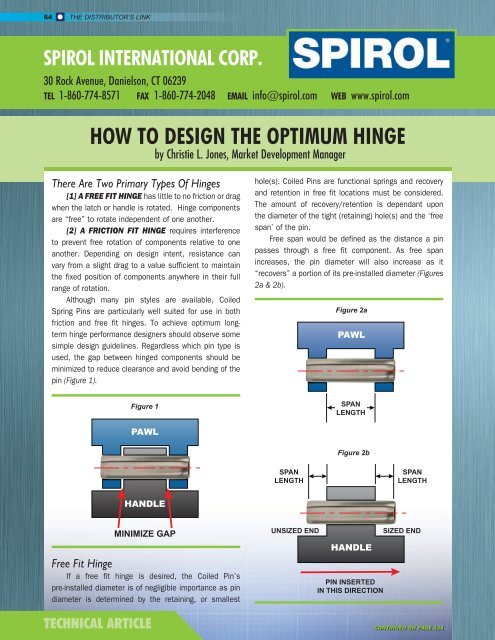SUMMER 2016
Distributor's Link Magazine Summer Issue 2016 / Vol 39 No3
Distributor's Link Magazine Summer Issue 2016 / Vol 39 No3
Create successful ePaper yourself
Turn your PDF publications into a flip-book with our unique Google optimized e-Paper software.
64<br />
THE DISTRIBUTOR’S LINK<br />
SPIROL INTERNATIONAL CORP.<br />
30 Rock Avenue, Danielson, CT 06239<br />
TEL 1-860-774-8571 FAX 1-860-774-2048 EMAIL info@spirol.com WEB www.spirol.com<br />
HOW TO DESIGN THE OPTIMUM HINGE<br />
by Christie L. Jones, Market Development Manager<br />
There Are Two Primary Types Of Hinges<br />
[1] A FREE FIT HINGE has little to no friction or drag<br />
when the latch or handle is rotated. Hinge components<br />
are “free” to rotate independent of one another.<br />
[2] A FRICTION FIT HINGE requires interference<br />
to prevent free rotation of components relative to one<br />
another. Depending on design intent, resistance can<br />
vary from a slight drag to a value sufficient to maintain<br />
the fixed position of components anywhere in their full<br />
range of rotation.<br />
Although many pin styles are available, Coiled<br />
Spring Pins are particularly well suited for use in both<br />
friction and free fit hinges. To achieve optimum longterm<br />
hinge performance designers should observe some<br />
simple design guidelines. Regardless which pin type is<br />
used, the gap between hinged components should be<br />
minimized to reduce clearance and avoid bending of the<br />
pin (Figure 1).<br />
hole(s). Coiled Pins are functional springs and recovery<br />
and retention in free fit locations must be considered.<br />
The amount of recovery/retention is dependant upon<br />
the diameter of the tight (retaining) hole(s) and the ‘free<br />
span’ of the pin.<br />
Free span would be defined as the distance a pin<br />
passes through a free fit component. As free span<br />
increases, the pin diameter will also increase as it<br />
“recovers” a portion of its pre-installed diameter (Figures<br />
2a & 2b).<br />
Figure 2a<br />
PAWL<br />
Figure 1<br />
SPAN<br />
LENGTH<br />
PAWL<br />
Figure 2b<br />
SPAN<br />
LENGTH<br />
SPAN<br />
LENGTH<br />
HANDLE<br />
MINIMIZE GAP<br />
Free Fit Hinge<br />
If a free fit hinge is desired, the Coiled Pin’s<br />
pre-installed diameter is of negligible importance as pin<br />
diameter is determined by the retaining, or smallest<br />
UNSIZED END<br />
HANDLE<br />
PIN INSERTED<br />
IN THIS DIRECTION<br />
SIZED END<br />
TECHNICAL ARTICLE CONTINUED ON PAGE 134

















